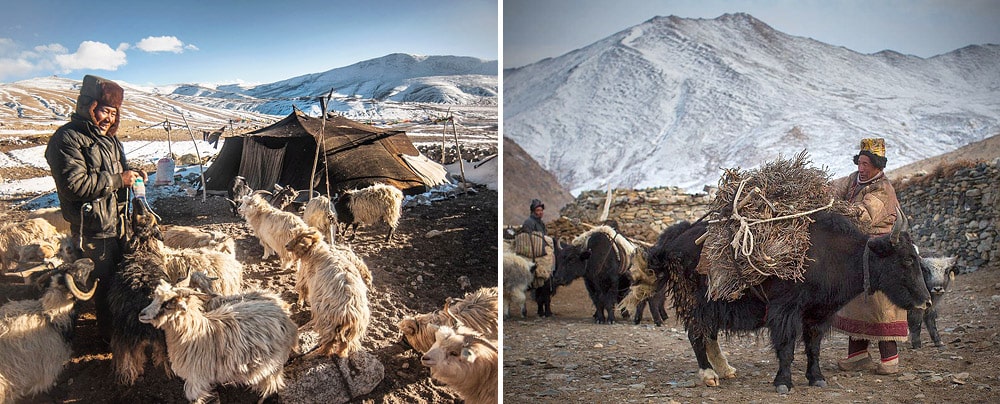Origins
The Changpas are a semi-nomadic people found mainly in the Changthang region of the Trans-Himalayas of the Indian subcontinent. This region typifies an extended part of the western region of the Tibetan plateau, which is an important tableland grazing ecosystem. These nomads originally migrated from Tibet in the eight century and a smaller number resides in the western region of the Tibetan Autonomous Region and were partially relocated for the establishment of the Changthang Nature Reserve.
The Changpa nomads share lingual and cultural affinities with Tibetans. They ramble across a vast stretch of pasture which serves as grazing land for both domestic and wild herbivorous. The land profile is characterized by rough terrain with rocky hills and high mountain ranges. Changthang is characterized by extreme cold temperatures, very low precipitation, high radiation and strong winds. Due to the high aridity, plant productivity is very low.

Nomadic pastoralism
The Changpas are nomadic pastoralists who predominantly rear sheep and goats. They also herd a variety of livestock like yaks for meat, milk and transportation, horses for riding, carrying loads and even ploughing agricultural fields. Since the early 1970s, many Changpa families have started raising cows for milk. All the livestock except the cows is grazed in the high pastures during most of the year. A Changpa’s main source of income is his livestock.
The Changpa nomads have been shepherding their world-class pashmina goats (or cashmere goats) for centuries and these goats are one of their main source of income. The famous pashmina wool is only obtained from a special breed of goats known as ChangRa, meaning the goat of the Changpas. These ChangRa are grazed on cold and high lands to produce fine pashmina wool.

Religion
The Changpa nomads are Buddhists. Religion and spirituality play an important role in their lives. The Changpas have their own festivals that they celebrate with joy and enthusiasm. One of the main purifying rituals of the Changpas is known as Jyabten where they make different kinds of food as an offering to Lord Padmasambhava. Their festival Tangpe Chona (15th day of the first month of the lunar calendar) is lively and vibrant. It celebrates the victory of good over evil.

Culture & tradition
Over the years, the Changpas have learned to live in harmony with nature and its surroundings. They do not fear the cold-winds, the rough terrain, and the harsh climate. They transmigrate with their makeshift tents known as rebo in search of green pastures for their livestocks in the valleys of Rupshu, Kharnak, Tso Moriri, and Mudh.
A rebo is made out of yak wool and is octagonal in shape. It has an opening in the roof to let out the chimney. The woollen tent is held together by stone walls. Each rebo invariably accommodates the family deity, and a picture of their spiritual head, in most cases the Dalai Lama.
The Changpas migrate four times a year with their belongings in the hope of finding better living conditions for themselves and their animals and also to trade their butter, meat, and wool. Trade plays an important part in their lives as the Changpa nomads cannot produce everything they consume. They trade their produce with basic necessities like cooking pots, grains, kerosene oil, etc.

Food
Milk is an integral part of the Changpas’ diet. With milk, they make cheese, curd, and butter. These are less perishable items that can be used for a longer period. Milk is obtained from yak, goat, and cow. The Changpa nomads consume fats in large amounts which keep their bodies warm and help them fight against the harsh climate of the region.
Apart from milk and its byproducts, the Changpas consume tsampa (roasted barley flour). Tsampa is their staple food, which is usually eaten along with butter tea or just butter. The nomads also consume wheat flour and sometimes rice as well.
During winters, it gets hard for the Changpas to find food so they kill goats and yaks and dry their meat for later consumption. They trade animals (alive or meat) for food products they don’t produce.
Due to lack of firewood in the Changthang region, the nomads use yak, cow, donkey and horse dungs as fuel for cooking and heating. For cooking, they use either a small kerosene stove or a bukhari (fireplace made of metal).

Clothing
Traditionally, Changpas make their clothes out of sheep wool. They sheer the wool of the sheep, make yarn out of the wool and weave it into fabric known as nambu. Their ceremonial attire is made from textiles, like brocade silk and velvet. They also wear the skin of sheep and goat known as lokpa as a cape to keep themselves warm. However, the pashmina they produce is worn less by them as it is not easy to process. Pashmina is mainly sold as raw material to the traders.

Photos: Cat Vinton and Andrew Newey
